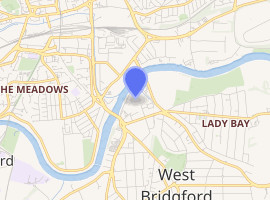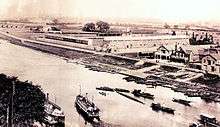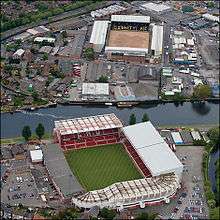City Ground
The City Ground is a football stadium in West Bridgford, Nottinghamshire, England, on the banks of the River Trent. It has been home to Nottingham Forest Football Club since 1898, and has 30,445 seats.
 | |

| |
| Full name | The City Ground |
|---|---|
| Location | City Ground, West Bridgford, Nottinghamshire, NG2 5FJ |
| Coordinates | 52°56′24″N 1°7′58″W |
| Public transit | |
| Owner | Nottingham City Council |
| Operator | Nottingham Forest |
| Capacity | 30,445[1] |
| Record attendance | 49,946 (Nottingham Forest vs Manchester United, 28 October 1967)[2] |
| Field size | 115 x 78 yards (105.2 x 71.3 metres)[1] |
| Surface | Grass (Undersoil Heating)[1] |
| Scoreboard | ADI Virtuality v8[3] |
| Construction | |
| Built | 1898[4] |
| Opened | 1898[4] |
| Expanded | 1957 (Former East Stand), 1965 (Peter Taylor Stand), 1980 (Brian Clough Stand), 1992-1993 (Bridgford Stand), 1994-1996 (Trent End)[4] |
| Architect | Husband & Co (1980), Miller Partnership (1992-1993, 1994-1996[5]) |
| General contractor | Taylor Woodrow (1992-1993, 1994-1996)[6] |
| Tenants | |
| Nottingham Forest (1898–present) | |
The stadium was a venue when England hosted Euro 96, and is only three hundred yards (270 m) away from Meadow Lane, home of Forest's neighbouring club Notts County; the two grounds are the closest professional football stadiums in England and the second-closest in the United Kingdom after the grounds of Dundee and Dundee United. They are located on opposite sides of the River Trent.
History

Nottingham Forest moved to their new ground on 3 September 1898 – 33 years after their formation and six years after election to the Football League.
To raise the £3,000 required to finance the move the club asked members, supporters and businessmen to subscribe to "New Ground Scheme" bearer bonds which cost £5 each. Over £2,000 was raised this way.
The new ground was called the City Ground. It was only a few hundred yards from the old Town Ground at the opposite end of Trent Bridge, which had been named after the Town Arms pub. Nottingham was granted its Charter as a City in 1897 and it was called the City Ground to commemorate this as the land on which it stands was at that time within the City boundary. In 1952 boundary changes resulted in the ground coming under the local council of West Bridgford (Rushcliffe Borough Council) rather than the City. Opposite the City Ground, still within the City boundaries, lies Meadow Lane, home of Notts County. The City Ground was wide open on three sides with no protection from the weather but the pitch was one of the finest in the country. This was due to the presence on the committee of J. W. Bardill, a nurseryman whose family firm still exists in Stapleford near Nottingham and whose company was given the task of preparing the pitch.
In 1935, the club had the opportunity to buy the ground from Nottingham Corporation for £7,000 but they declined.
On 12 October 1957, a new East Stand opened at the City Ground, costing £40,000 and having benches to seat up to 2,500 fans. The visitors for the opening were Manchester United’s "Busby Babes", just four months before eight of them died in the Munich air disaster. On 11 September 1961, the floodlights at the ground were officially turned on for the first time as Forest faced Gillingham in the League Cup.[7] A new record attendance of 49,946 was set in October 1967 when Forest beat Manchester Utd 3-1 in a First Division fixture, five months after Forest had finished second to United in the league. In December 1967 the City Ground was host to an England U23 match against Italy.[8]
The Main Stand was largely rebuilt in 1965 but, on 24 August 1968, fire broke out during a First Division game against Leeds United.[9] It started in the boiler room, just before half-time. The stand was damaged but, despite a crowd numbering 31,126, none of them were injured.[9] The only reported injuries were to a television crew on the TV gantry, who had to scramble down it because the access ladder was stored in the boiler room. The gantry was extended the length of the stand and now has access at both ends. As a result of the fire, Forest played six 'home' matches at nearby Meadow Lane and did not win one of them. Sadly many of the club's records, trophies and other memorabilia were lost in the fire. The stand was refurbished.
 A front view of the Main Stand during the fire
A front view of the Main Stand during the fire A rear view of the Main Stand during the fire
A rear view of the Main Stand during the fire
The Executive Stand was built in 1980 at a cost of £2 million — largely from proceeds of the highly successful era in which Forest brought the European Cup back to Nottingham in 1979 and 1980, having won the league title in 1978. Forest also won the Football League Cup twice during that era.
Under Clough's reign, Forest had taken the English domestic game and the European scene by storm and money raised from those successes was invested in a stand that had a capacity of 10,000. It was renamed The Brian Clough Stand after his retirement, and was re-opened after refurbishment by the man himself in the mid-1990s. The stand also incorporated 36 executive boxes and a large dining area, which was designed to be the focus of the club's corporate hospitality arrangements.

Nottingham Forest had been the opposing team in the fateful FA Cup semi-final against Liverpool at Hillsborough, Sheffield, on 15 April 1989, in which 96 Liverpool fans were fatally injured in a human crush on the stadium's terraces. The disaster resulted in the Taylor Report ordering that all clubs in the top two divisions of English football should have an all-seater stadium by August 1994. This resulted in the need for more redevelopment and refurbishment at the City Ground.
More major development took part in 1992–93 with the rebuilding of the Bridgford Stand. Work started in April 1992 and when completed the Stand had a capacity of 7,710, the lower tier of 5,131 being allocated to away supporters. The unusual shape of the roof was a planning requirement to allow sunlight to reach houses in nearby Colwick Road. The Stand includes accommodation for 70 wheelchair supporters.[10] It also houses a management suite, which includes the public address systems, computerised electronic scoreboard controls and the police matchday operation.
The Trent End was the most recent stand to be rebuilt between 1994 and 1996 — in time for Euro 96, the European Football Championships. The new stand, such a prominent landmark by the River Trent, held 7,338 to take the ground's capacity to 30,576 all-seated.
The ground would be able to expand to up to 46,000 if ever there was ever a return to the top flight. Forest were relegated from the FA Premier League three times between 1993 and 1999. Although they achieved promotion at the first attempt following the first two relegations, they have yet to return to the Premier League since their relegation in 1999 and even spent three seasons in League One - English football's third tier.
On 20 June 2007, the Forest board announced plans for a possible relocation to a new 50,000-seat stadium in the city, although such a move was not expected to take place before 2014. This was part of England's bid to host the 2018 World Cup, but in December 2010 England's World Cup bid was rejected in favour of Russia being selected as the host nation.
Several improvements to the stadium have been made since the Trent End rebuild such as two new LED Screens being installed between the Trent End and the Brian Clough Stand and in the far corner of the Bridgford Stand. A small number of seats were lost because of this. LED advertising boards were also installed around the perimeter of the pitch excluding the Main Stand. These improvements cost around £1 million.
The City Ground also hosted the FA Women's Cup Final for two successive years in 2007 and 2008. The 2007 final was contested by Arsenal L.F.C. and Charlton Athletic L.F.C. with the attendance of 24,529 smashing the previous record attendance for the competition of 13,824 for the final between Arsenal L.F.C. and Fulham L.F.C. at Selhurst Park in 2001. In 2008, the attendance record was broken once again when 24,582 spectators saw Arsenal L.F.C. beat Leeds United 4–1.
Aside from football, the stadium has also hosted two other large-scale events. On 28 April 2002 the stadium hosted a semi-final of rugby's Heineken Cup in which Leicester Tigers beat Llanelli Scarlets 13–12. Leicester Tigers once again played at City Ground when they were defeated 19-16 by Racing 92 on 24 April 2016 in the semi-final of the European Rugby Champions Cup. The stadium hosted its first music concert when R.E.M. performed there[11] in front of an audience of 20,000.
In October 2015, Forest renamed the Main Stand, "The Peter Taylor Stand" after former European Cup winning assistant-manager Peter Taylor, who died 25 years earlier.[12]
Following issues with the ground's safety certificate, the capacity of the stadium was reduced to 24,357 ahead of the 2016–17 season.[13]
Proposed relocation
In June 2007, Nottingham Forest announced plans to leave the City Ground after more than 100 years, with the aim of Nottingham having a ground suitable to hold matches for the 2018 World Cup, for which England was a bidding nation. The City Ground was deemed unsuitable, even with expansion, due to the areas that needed to be available for fan parks around the stadium; the City Ground is in a dense urban area, surrounded by private housing, businesses and industry. The initial plan was to move to a new 50,000-seater purpose built stadium in Clifton towards the south of the city, forming part of a new housing and leisure development. However, this location was soon changed to a site at Gamston due to logistical problems surrounding plans for a Clifton ground, such as potential matchday pressures on the proposed Nottingham Express Transit tram extension and the A453.
Plans for the Gamston ground were exhibited to the FA World Cup committee in 2009, and Nottingham's plans for a new ground and waterside Fan Park using the River Trent, meant they were successful in getting through to the next stage of potential host cities for the 2018 World Cup bid, even beating plans by neighbours Derby and Leicester, who already had new stadiums but were eliminated from the Host City pool. However, objection from Gamston residents and its out-of-town location has meant that afterwards, this Stadium site changed again, with the City Council looking towards an area of wasteland currently being redeveloped, known as Eastside, around a mile to the East of the city centre near the Sneinton area.
Around 2002, there were plans to rebuild the City Ground's Main Stand (on the condition that Forest return to the Premier League) – a plan which would make the ground up to around 40,000 capacity. However, Forest now justified the new ground plan over the previously proposed City Ground Main Stand extension by suggesting that the current 'new' stands (Trent End, Brian Clough Stand, Bridgford Stand) were in a state which, 10 years down the line, would be money intensive on club funds, along with other complex FIFA host ground restrictions. Much of the funding for the brand new stadium however would be from the private sector or Nottingham City Council.
Possible stadium names were suggested by some supporters, including the Brian Clough Arena, the New City Ground, City of Nottingham Stadium, and the Robin Hood Arena.
Due to the 2018 FIFA World Cup being awarded to Russia, plans for a new ground were shelved. By 2019, the club had decided to remain at the City Ground and rebuild the Main Stand.
Ground redevelopment
On 28 February 2019 the club confirmed an extended lease on the City Ground, allowing it to proceed with plans to redevelop the stadium and surrounding area. Central to this will be the replacement of the current Peter Taylor Stand with a new 10,000-seater stand, and improvements to the Trentside area, Brian Clough and Bridgford Stands.
The new Peter Taylor Stand will see the introduction of a museum, new club shop, executive boxes, and a range of hospitality lounge options and restaurants.[14]
The club is hopeful that building work will commence at the end of the 2019–20 season. The new, modern, state-of-the-art structure will see the City Ground's capacity become the highest in the East Midlands, reaching 38,000 after completion.[15]
UEFA Euro 1996 matches
The following games were played at the City Ground during the opening phase of the UEFA Euro 96 tournament.
| Date | Result | Round | ||
|---|---|---|---|---|
| 11 June 1996 | 0–1 | Group D | ||
| 14 June 1996 | 1–0 | Group D | ||
| 19 June 1996 | 0–3 | Group D |
Images


Notes and references
- "Nottingham Forest - City Ground". Football Ground Guide. Retrieved 26 August 2019.
- "Club Records". Nottingham Forest Football Club. Retrieved 26 August 2019.
- "Nottingham Forest Case Study". adi.tv. Retrieved 26 August 2019.
- "History of The City Ground". Nottingham Forest Football Club. Retrieved 26 August 2019.
- "31May91 UK: TAYLOR WOODROW TO BUILD NEW STAND FOR NOTTINGHAM FOREST FOOTBALL CLUB". Construction News. Retrieved 26 August 2019.
- "Football is top of the league for the construction industry. Ground rebuilding keeps the hard-hit sector busy". The Herald Scotland. Retrieved 26 August 2019.
- "Undefined Headline". Nottingham Post. 27 September 2014. pp. 20–21. Retrieved 28 November 2015.
- "MADELEY OUT OF ENGLISH TEAM". The Herald. Glasgow. 8 December 1967. p. 6. Retrieved 9 February 2015.
- "The day fire ripped through City Ground". The Nottingham Post. London: Trinity Mirror plc. 10 December 2009. Archived from the original on 21 July 2016. Retrieved 21 July 2016.
- "Forest fans 'furious' over seating changes". BBC News. 22 May 2013. Retrieved 28 May 2013.
- "City Ground, Nottingham - 6th July - R.E.M. summer shows 2005". efestivals.co.uk. 13 July 2005. Retrieved 28 May 2013.
- http://www.nottinghamforest.co.uk/news/article/in-peters-honour-2723604.aspx
- "Nottingham Forest: Championship club have their capacity reduced by 20%". BBC Sport. 26 July 2016.
- "City Ground redevelopment – what you need to know". Cartwright. 1 May 2019. Retrieved 6 December 2019.
- "Major Redevelopment of the City Ground". Nottingham Forest Football Club. 28 February 2019.
External links
| Wikimedia Commons has media related to City Ground, Nottingham. |